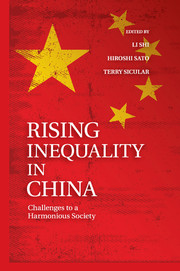Book contents
- Frontmatter
- Contents
- List of Tables
- List of Figures
- Contributors
- Preface
- Abbreviations
- Glossary
- 1 Rising Inequality in China
- 2 Overview
- 3 Housing Ownership, Incomes, and Inequality in China, 2002–2007
- 4 Educational Inequality in China
- 5 Inequality and Poverty in Rural China
- 6 The Evolution of the Migrant Labor Market in China, 2002–2007
- 7 A New Episode of Increased Urban Income Inequality in China
- 8 Unemployment and the Rising Number of Nonworkers in Urban China
- 9 Do Employees in the Public Sector Still Enjoy Earnings Advantages?
- 10 Redistributive Impacts of the Personal Income Tax in Urban China
- 11 Changes in the Gender-Wage Gap in Urban China, 1995–2007
- 12 Intertemporal Changes in Ethnic Urban Earnings Disparities in China
- Appendix I The 2007 Household Surveys
- Appendix II The 2002 and 2007 CHIP Surveys
- Index
- References
6 - The Evolution of the Migrant Labor Market in China, 2002–2007
Published online by Cambridge University Press: 05 July 2013
- Frontmatter
- Contents
- List of Tables
- List of Figures
- Contributors
- Preface
- Abbreviations
- Glossary
- 1 Rising Inequality in China
- 2 Overview
- 3 Housing Ownership, Incomes, and Inequality in China, 2002–2007
- 4 Educational Inequality in China
- 5 Inequality and Poverty in Rural China
- 6 The Evolution of the Migrant Labor Market in China, 2002–2007
- 7 A New Episode of Increased Urban Income Inequality in China
- 8 Unemployment and the Rising Number of Nonworkers in Urban China
- 9 Do Employees in the Public Sector Still Enjoy Earnings Advantages?
- 10 Redistributive Impacts of the Personal Income Tax in Urban China
- 11 Changes in the Gender-Wage Gap in Urban China, 1995–2007
- 12 Intertemporal Changes in Ethnic Urban Earnings Disparities in China
- Appendix I The 2007 Household Surveys
- Appendix II The 2002 and 2007 CHIP Surveys
- Index
- References
Summary
Introduction
Migration simply did not figure in the first of the China Household Income Project (CHIP) volumes, which was based on a 1988 national household survey (Griffin and Zhao 1993). This was partly because that survey relied entirely on samples drawn from the annual national household survey of the National Bureau of Statistics (NBS), which contained only rural households and urban hukou (household registration) households. That sampling procedure in turn reflected the underlying reality: rural-urban migration was restricted, limited, and unimportant. The same is true of the volume based on the 1995 CHIP survey (Riskin, Zhao, and Li 2001), although it contains an analysis of migrants based on the rural sample (Li 2001). The 2002 CHIP survey was the first to include a separate sample of rural migrants to the cities, and migrants were integrated into several of the chapters in the resultant volume (Gustafsson, Li, and Sicular 2008). A sample of rural-urban migrants was again included in the 2007 CHIP survey, on which the current volume is based. The greater emphasis given to migrants and migration in each succeeding CHIP survey reflects an important development in the Chinese economy. What has been referred to as the greatest migration in human history is now critical to an analysis of China's economic growth, income distribution, poverty alleviation, and labor market. Indeed, it is the subject of a separate volume that is also based on the 2007 survey (Meng and Manning 2010), but that volume does not address the question posed in this chapter.
The famous Lewis model (Lewis 1954) provides a good framework for evaluating the success of a developing economy and for explaining the ways in which the fruits of economic development are spread. Within a competitive market economy, it is only when the economy emerges from the first, labor-surplus, classical stage of the development process and enters the second, labor-scarce, neoclassical stage that real incomes generally begin to rise.
- Type
- Chapter
- Information
- Rising Inequality in ChinaChallenges to a Harmonious Society, pp. 230 - 254Publisher: Cambridge University PressPrint publication year: 2013



